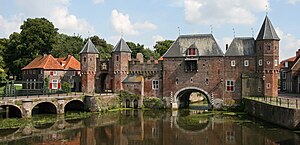

The Koppelpoort is a medieval gate in the Dutch city of Amersfoort, province of Utrecht. Completed around 1425, it combines land and water-gates, and is part of the second city wall of Amersfoort, which was constructed between 1380 and 1450. [1]


The Koppelpoort is a medieval gate in the Dutch city of Amersfoort, province of Utrecht. Completed around 1425, it combines land and water-gates, and is part of the second city wall of Amersfoort, which was constructed between 1380 and 1450. [1]
The gate was built between 1380 and 1425 as part of the second city wall. The whole wall was completed around 1450. The gate was attacked in 1427 during the siege of the city. This attack was repelled.
The gate was opened and closed every day by the appointed raddraaiers, "wheel-turners". A minimum of twelve wheel-turners were collected morning and evening by several guards. It was an extremely dangerous task; if they did not begin walking simultaneously, then one could fall, dragging the rest along with often fatal results. Before the gate could come down, it had to be raised, to pull out the iron pins that held it in place. Only then could it come down. While the gate was going down, walking in the wheel grew ever easier and faster, and many people stumbled and broke their limbs. The koppelpoort was also never breached.
The Koppelpoort was given its current appearance during the restoration by Pierre Cuypers in 1885 and 1886. Among other things, Cuypers removed a step between the two gates and replaced it with a slope.
From 1969 to 1993 a puppet theater was situated in the gate.
The latest restoration was completed in 1996. It was carried out very cautiously, and with respect for the old building materials. For this the town of Amersfoort received the Europa Nostra Award. [2]

Amersfoort is a city and municipality in the province of Utrecht, Netherlands. As of 31 January 2023, the municipality had a population of 160,902, making it the second-largest of the province and fifteenth-largest of the country. Amersfoort is also one of the largest Dutch railway junctions with its three stations—Amersfoort Centraal, Schothorst and Vathorst—due to its location on two of the Netherlands' main east to west and north to south railway lines. The city was used during the 1928 Summer Olympics as a venue for the modern pentathlon events. Amersfoort marked its 750th anniversary as a city in 2009.

Valkenburg aan de Geul is a municipality situated in the southeastern Dutch province of Limburg. The name refers to the central town in the municipality, Valkenburg, and the small river Geul passing through it.

A city gate is a gate which is, or was, set within a city wall. It is a type of fortified gateway.

The Visoki Dečani Monastery is a medieval Serbian Orthodox Christian monastery located near Deçan, Kosovo. It was founded in the first half of the 14th century by Stefan Dečanski, King of Serbia. It is often considered to be one of the most endangered European cultural heritage sites and with a designation of Cultural Monument of Exceptional Importance.

Amsterdam Centraal station is the largest railway station in Amsterdam, North Holland, the Netherlands. A major international railway hub, it is used by 192,000 passengers a day, making it the second busiest railway station in the country after Utrecht Centraal and the most visited Rijksmonument of the Netherlands.
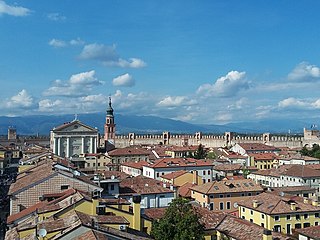
Cittadella is a medieval walled city in the province of Padua, northern Italy, founded in the 13th century as a military outpost of Padua. The surrounding wall has been restored and is 1,461 metres (4,793 ft) in circumference with a diameter of around 450 metres (1,480 ft). There are four gates which roughly correspond the points of the compass.

Monkodonja is a hillfort occupied about 1850/1750-1500/1450 BC during the Bronze Age, located near the city of Rovinj in the Croatian region of Istria.

De Haar Castle is located outside Utrecht, Netherlands. It is the largest castle in The Netherlands.

Haarlemmerbuurt is a neighbourhood in Amsterdam, in the Dutch province of North Holland, and is part of the borough Centrum. The central artery of the area is formed by the streets Haarlemmerdijk and Haarlemmerstraat, the old road to Haarlem. The neighbourhood is bordered to the south by Brouwersgracht, to the west by Singelgracht, on the north by the railway embankment and on the east by Singel.
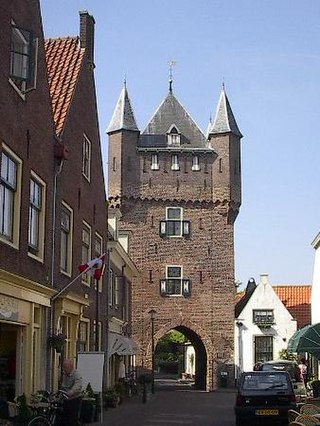
The Dijkpoort is a 14th-century citygate in Hattem, the Netherlands. In 1908, the gate was restored in order to house the archives of Hattem under the direction of the city archivist F.A. Hoefer.

Southampton's town walls are a sequence of defensive structures built around the town in southern England. Although earlier Roman and Anglo-Saxon settlements around Southampton had been fortified with walls or ditches, the later walls originate with the move of the town to the current site in the 10th century. This new town was defended by banks, ditches and the natural curve of the river and coastline. The Normans built a castle in Southampton but made no attempts to improve the wider defences of the town until the early 13th century, when Southampton's growing prosperity as a trading centre and conflict with France encouraged the construction of a number of gatehouses and stone walls to the north and east sides of the settlement.

The Waag is a 15th-century building on Nieuwmarkt square in Amsterdam. It was originally a city gate and part of the walls of Amsterdam. Later it served as a guildhall, museum, fire station and anatomical theatre, among other things.

The walls of Amsterdam were built in the Middle Ages to protect the city against attack. The Medieval walls were replaced with a series of bastions in the 17th century. In the 19th century, the walls were torn down and replaced with the Defence Line of Amsterdam, a fortification line which encircled Amsterdam at a distance from the city.

Canterbury city walls are a sequence of defensive walls built around the city of Canterbury in Kent, England. The first city walls were built by the Romans, probably between 270 and 280 AD. These walls were constructed from stone on top of an earth bank, and protected by a ditch and wall towers. At least five gates were placed into the walls, linked to the network of Roman roads across the region. With the collapse of Roman Britain, Canterbury went into decline but the walls remained, and may have influenced the decision of Augustine to settle in the city at the end of the 6th century. The Anglo-Saxons retained the defensive walls, building chapels over most of the gates and using them to defend Canterbury against Viking incursions.
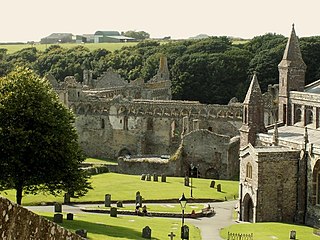
St Davids Bishops Palace is a ruined medieval palace located adjacent to St Davids Cathedral in the city of St Davids, Pembrokeshire, one of the most important ecclesiastical sites in Wales. The site dates back to the 6th century, although the building that stands today dates largely from the late 13th and 14th centuries.

Radboud Castle is a castle on the east bank of the harbour in Medemblik.

The fortifications of Mdina are a series of defensive walls which surround the former capital city of Mdina, Malta. The city was founded as Maleth by the Phoenicians in around the 8th century BC, and it later became part of the Roman Empire under the name Melite. The ancient city was surrounded by walls, but very few remains of these have survived.
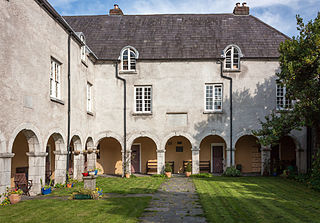
Skiddy's Almshouse is the oldest inhabited building in the city of Cork. It was built in 1718 and finished in 1719.

The Spuistraat in downtown Amsterdam connects the Hekelveld to the Spui. It runs roughly north to south, parallel to the Singel and the Nieuwezijds Voorburgwal. At the Royal Palace of Amsterdam, the Spuistraat crosses the Raadhuisstraat and Paleisstraat. Originally the Spuistraat was a canal, the Nieuwezijds Achterburgwal. The canal was filled in in 1867, and the street renamed then.

The Utrecht Schism was a diocesan feud in the Prince-Bishopric of Utrecht from 1423 to 1449. The legitimate prince-bishop of Utrecht was at issue. The war of succession was fought by Zweder van Culemborg and his brother Walraven van Meurs against Rudolf van Diepholt. The conflict mixed with the existing Utrecht factionalism between the Lichtenbergers and Lokhorsten and with the Hook and Cod wars raging in the County of Holland. Some scholars consider the Utrecht Schism to have ended in 1429.
52°09′32″N5°23′07″E / 52.15889°N 5.38528°E